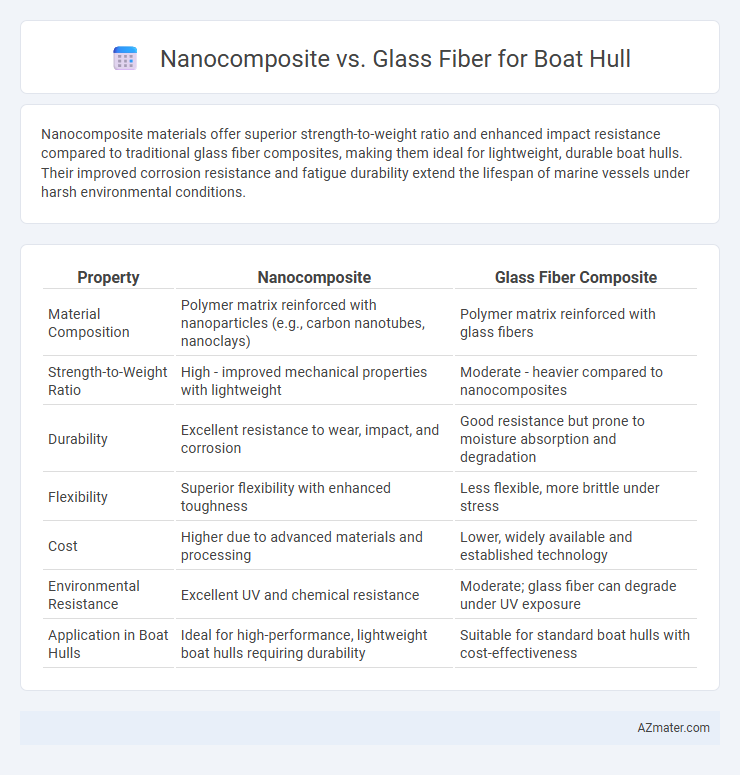Nanocomposite materials offer superior strength-to-weight ratio and enhanced impact resistance compared to traditional glass fiber composites, making them ideal for lightweight, durable boat hulls. Their improved corrosion resistance and fatigue durability extend the lifespan of marine vessels under harsh environmental conditions.
Table of Comparison
| Property | Nanocomposite | Glass Fiber Composite |
|---|---|---|
| Material Composition | Polymer matrix reinforced with nanoparticles (e.g., carbon nanotubes, nanoclays) | Polymer matrix reinforced with glass fibers |
| Strength-to-Weight Ratio | High - improved mechanical properties with lightweight | Moderate - heavier compared to nanocomposites |
| Durability | Excellent resistance to wear, impact, and corrosion | Good resistance but prone to moisture absorption and degradation |
| Flexibility | Superior flexibility with enhanced toughness | Less flexible, more brittle under stress |
| Cost | Higher due to advanced materials and processing | Lower, widely available and established technology |
| Environmental Resistance | Excellent UV and chemical resistance | Moderate; glass fiber can degrade under UV exposure |
| Application in Boat Hulls | Ideal for high-performance, lightweight boat hulls requiring durability | Suitable for standard boat hulls with cost-effectiveness |
Introduction to Boat Hull Materials
Boat hull materials significantly impact vessel performance, durability, and weight efficiency, with nanocomposites and glass fiber being prominent options. Nanocomposites offer enhanced mechanical properties by integrating nanoparticles, resulting in increased strength, impact resistance, and reduced weight compared to traditional glass fiber composites. Glass fiber remains widely used due to its cost-effectiveness, ease of fabrication, and good corrosion resistance, but nanocomposites provide a cutting-edge alternative for high-performance marine applications.
What Are Nanocomposites?
Nanocomposites are advanced materials composed of a polymer matrix reinforced with nanoparticles, offering superior mechanical properties and enhanced durability compared to traditional composites. In boat hull construction, nanocomposites provide increased strength-to-weight ratio, improved impact resistance, and better corrosion resistance than glass fiber composites. This innovation leads to lighter, more resilient boat hulls that extend service life and reduce maintenance costs in marine environments.
Understanding Glass Fiber in Marine Applications
Glass fiber remains a dominant material in marine applications due to its excellent strength-to-weight ratio, corrosion resistance, and cost-effectiveness for boat hull construction. Its fibrous structure provides flexibility and impact resistance, essential for withstanding harsh marine environments such as saltwater exposure and mechanical stresses. Compared to nanocomposites, glass fiber offers proven durability and ease of repair, making it a reliable choice for both recreational and commercial vessels.
Weight and Strength Comparison
Nanocomposites offer significant advantages over traditional glass fiber in boat hull construction due to their superior strength-to-weight ratio. While glass fiber composites typically provide tensile strengths around 2,500 MPa at densities near 2.5 g/cm3, nanocomposites can achieve comparable or higher strength levels with densities as low as 1.5 g/cm3, resulting in lighter hulls with enhanced mechanical performance. The integration of nanoparticles like carbon nanotubes or graphene improves stiffness and impact resistance, reducing overall weight without compromising structural integrity in marine environments.
Durability and Longevity
Nanocomposite materials provide enhanced durability for boat hulls by offering superior resistance to impacts, corrosion, and UV degradation compared to traditional glass fiber composites. The nano-scale fillers in nanocomposites improve mechanical strength and reduce water absorption, significantly extending hull longevity in harsh marine environments. Glass fiber remains popular due to cost-effectiveness and ease of repair but generally exhibits shorter lifespan and higher maintenance requirements than advanced nanocomposite hulls.
Resistance to Corrosion and Water Damage
Nanocomposites exhibit superior resistance to corrosion and water damage compared to traditional glass fiber composites due to their enhanced matrix properties and nanoscale filler dispersion, which significantly reduce water absorption and chemical degradation. Glass fiber hulls are prone to water ingress through micro-cracks and osmotic blistering, leading to structural weakening and increased maintenance costs. The integration of nanomaterials improves barrier performance and durability, making nanocomposite boat hulls a more reliable option for prolonged exposure to harsh marine environments.
Manufacturing and Fabrication Processes
Nanocomposite boat hulls utilize advanced manufacturing techniques such as resin infusion and hot pressing, resulting in superior fiber dispersion and minimized void content compared to traditional glass fiber layup processes. Glass fiber hull fabrication typically involves hand layup or spray-up methods, which are labor-intensive and can lead to variable fiber alignment and thickness, impacting structural consistency. Nanocomposites enable faster curing times and higher precision molding, enhancing overall hull strength and reducing production time in marine applications.
Cost Analysis: Nanocomposite vs Glass Fiber
Nanocomposite materials for boat hulls typically present higher initial costs due to advanced manufacturing processes and raw material expenses, whereas glass fiber remains more cost-effective with established production techniques and widespread availability. Lifecycle cost analysis often shows nanocomposites offer superior durability and reduced maintenance, potentially offsetting upfront investment over time. Glass fiber's affordability is attractive for budget-conscious projects, but nanocomposites provide enhanced strength-to-weight ratios, which can lead to fuel savings and performance benefits in the long term.
Environmental Impact and Sustainability
Nanocomposite materials in boat hulls offer enhanced durability and reduced weight compared to traditional glass fiber, leading to improved fuel efficiency and lower carbon emissions during operation. The production of nanocomposites often involves less energy-intensive processes and can incorporate bio-based polymers, increasing sustainability and reducing reliance on non-renewable resources. Glass fiber composites, while widely used, pose challenges in recycling and generate more waste, making nanocomposites a more environmentally responsible choice for sustainable boat manufacturing.
Which Material is Best for Modern Boat Hulls?
Nanocomposite materials offer superior strength-to-weight ratios and enhanced corrosion resistance compared to traditional glass fiber, making them increasingly popular for modern boat hull construction. Glass fiber remains cost-effective and widely used due to its proven durability and ease of repair, but nanocomposites provide improved impact resistance and longer lifespan in harsh marine environments. Choosing the best material depends on balancing performance requirements, budget constraints, and the intended use of the vessel.

Infographic: Nanocomposite vs Glass fiber for Boat hull
 azmater.com
azmater.com